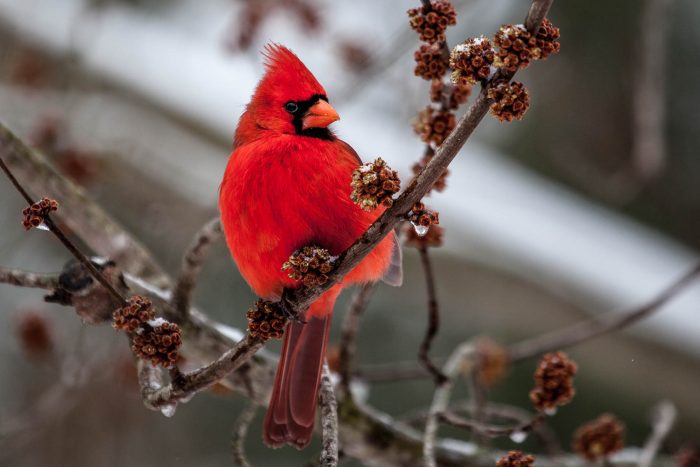Northern Cardinal
Cardinalis cardinalis
The northern cardinal is a small, red songbird that lives in gardens, backyards and wooded areas throughout the Chesapeake Bay watershed.
This section shows one large critter image at a time. Use the thumbnails that follow to select a specific image to display here.

This gallery contains a grid of small thumbnails. Selecting a thumbnail will change the main image in the preceding section.
Appearance
Cardinals grow to 7 to 9 inches in length with a long tail. They have a distinctive tall, sharp crest of feathers on top of their head and an orange, cone-shaped beak. Males are brilliant red with a black face, while females are brownish-gray with a reddish crest, wings and tail.
Feeding
Cardinals eat seeds, insects and small fruits. Their cone-shaped bill allows them to easily crack open seeds. They will often eat grains from backyard bird feeders.
Predators
Hawks, squirrels, owls, snakes, blue jays, and domestic dogs and cats prey upon cardinals.
Flight
Males are easily identified in flight by their brilliant red color.
Voice
Both males and females sing, and are known for their what-cheer, cheer, cheer; purty-purty-purty-purty or sweet-sweet-sweet-sweet calls. Calls can vary depending on geography.
Reproduction and life cycle
Pairs, which are monogamous, breed in March and again in May-July. They begin by establishing a breeding territory and exchanging songs. Females build a small, cup-shaped nest in a dense shrub, small tree or tangle of vines. They lay 3-4 eggs, usually two times per year. While the female incubates the eggs for about two weeks, the male aggressively guards the nest. Cardinals defend their territory so well that they will attack their own reflection in windows, mirrors and other shiny surfaces.
Newly hatched cardinal young are extremely immature and vulnerable: they cannot move, their eyes are closed and they have no down. They require intense care from both parents for about 10 days after hatching. After that time, they are able to leave the nest. As young male cardinals develop their brilliant red color, the male parent usually expels them from the nest.
Did you know?
- Cardinals are the state bird of the watershed states of Virginia and West Virginia, as well as of many states outside the watershed.
- These birds are named after Catholic cardinals, who wear bright red robes.
Sources and additional information
- Animal Diversity Web: Cardinalis cardinalis – University of Michigan Museum of Zoology
- All About Birds: Northern Cardinal – The Cornell Lab of Ornithology
- NatureWorks: Northern Cardinal – New Hampshire Public Television
